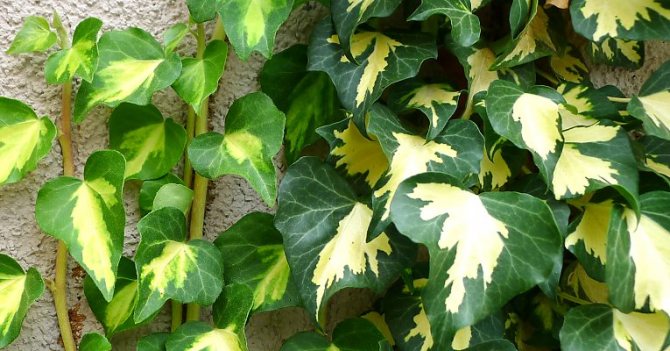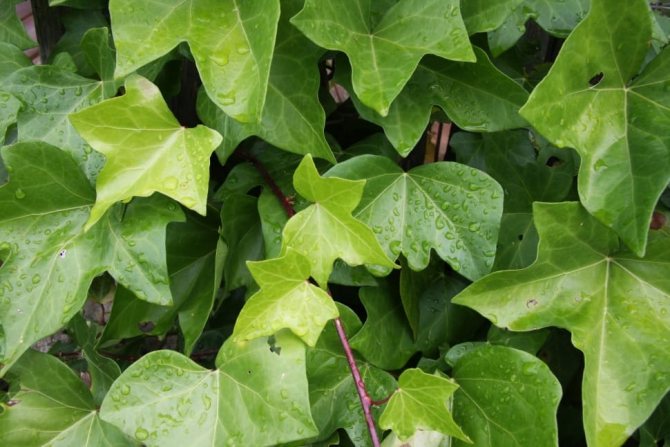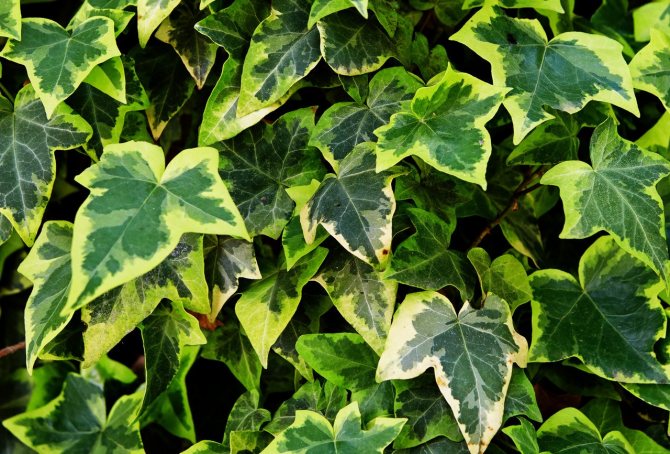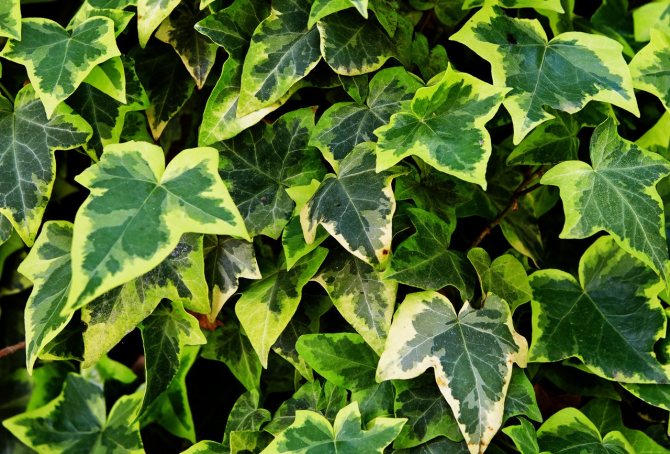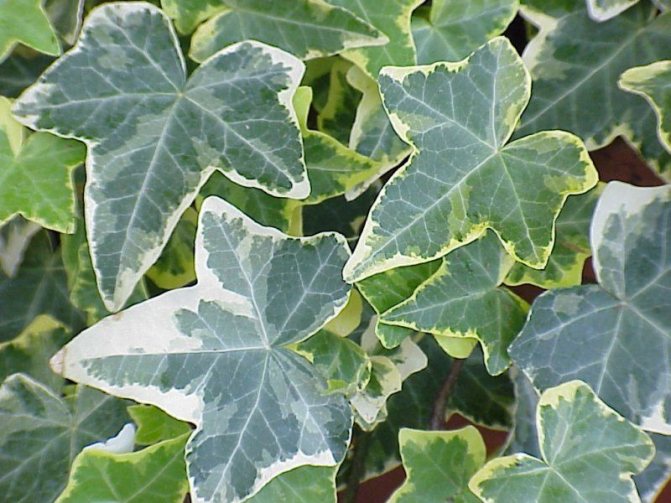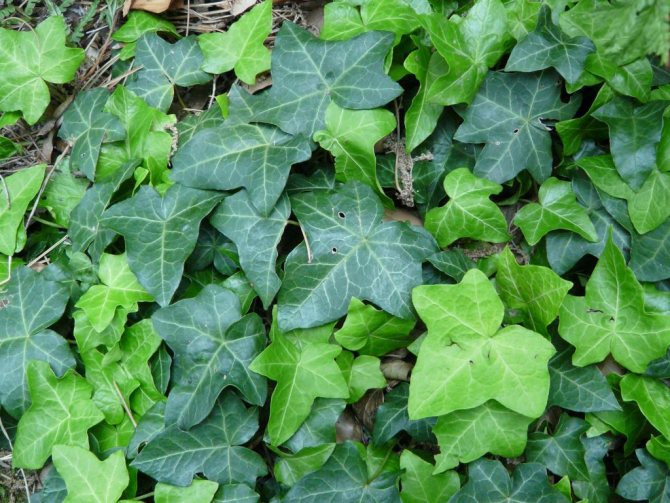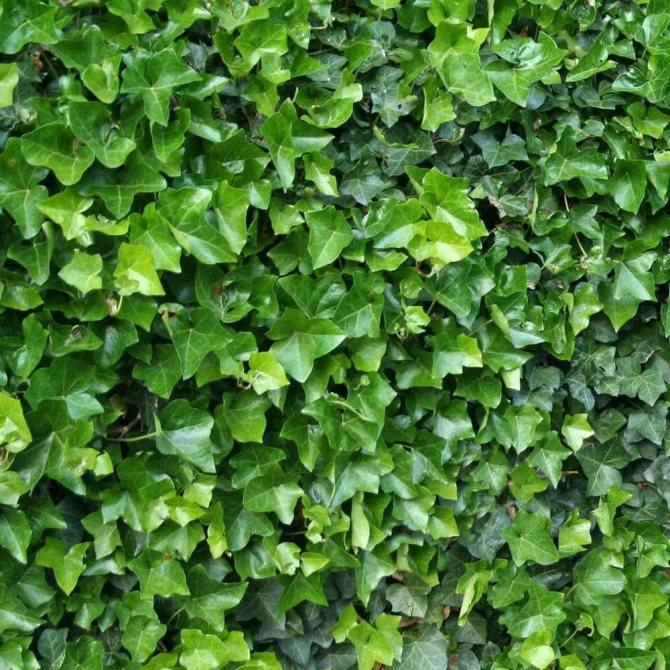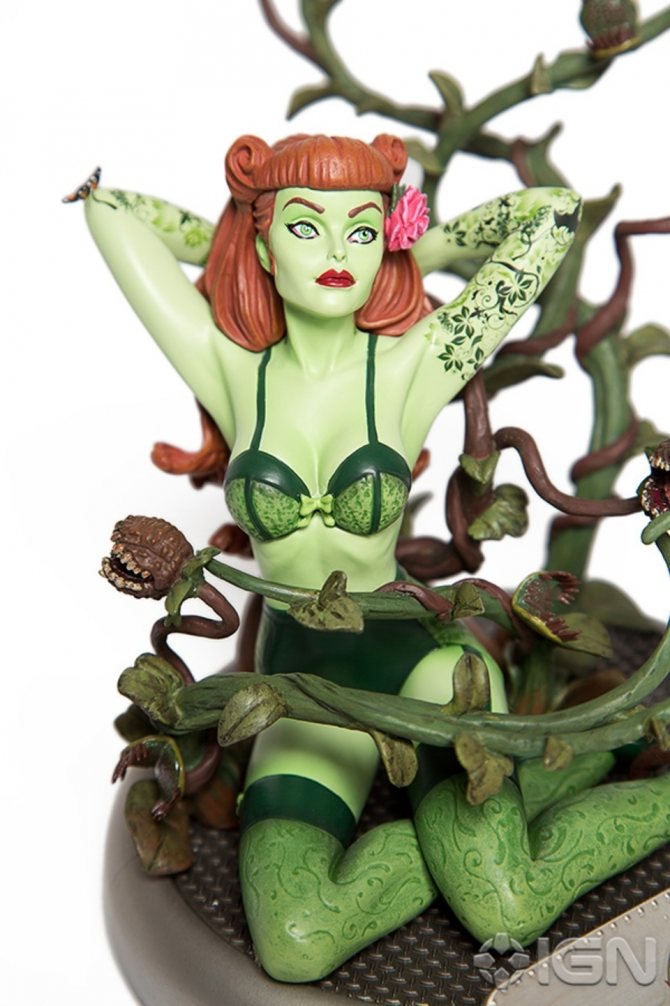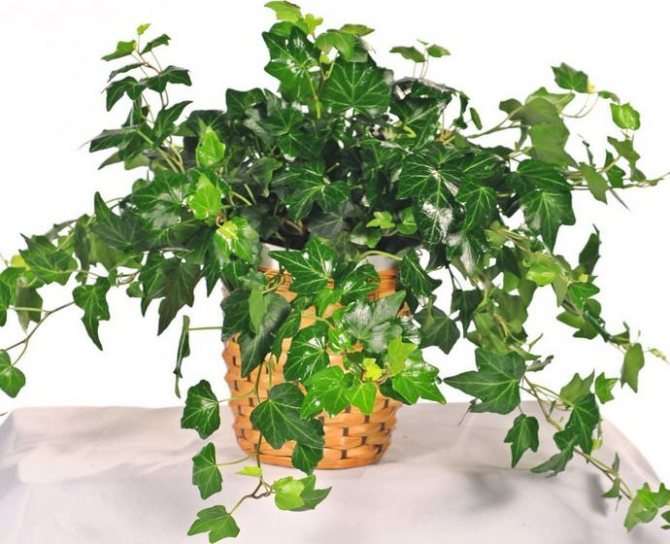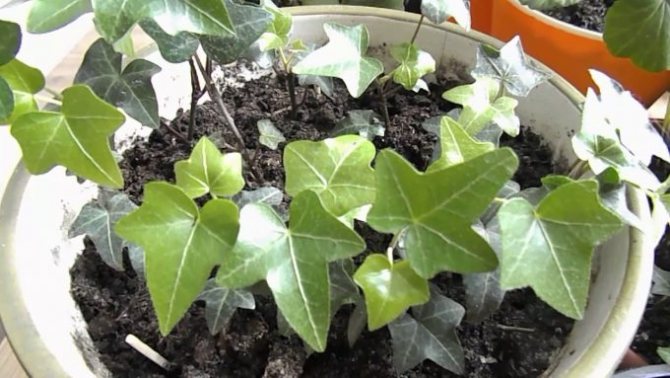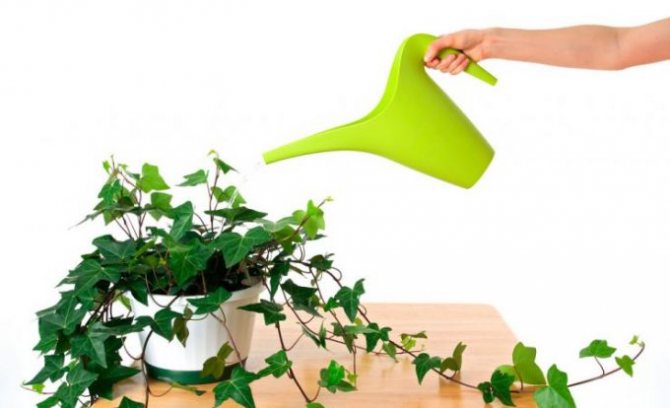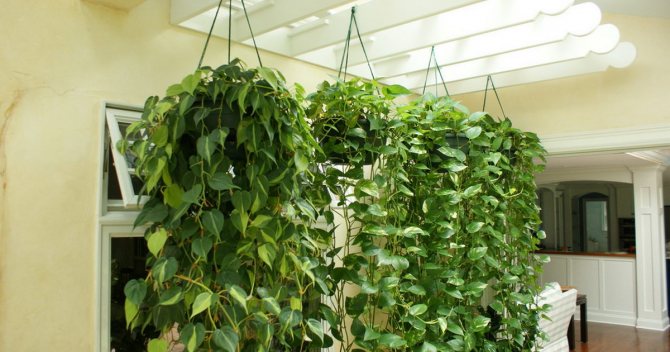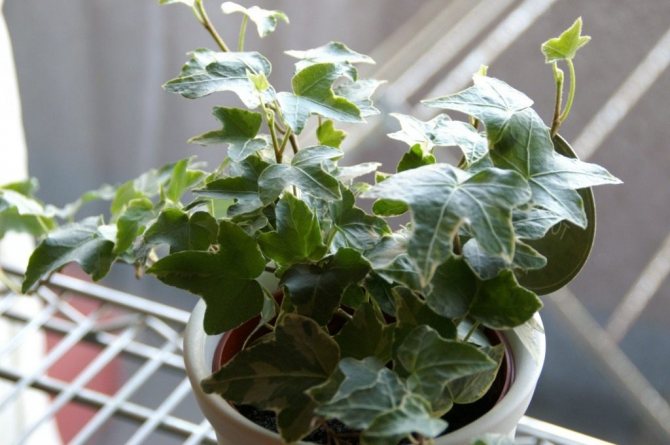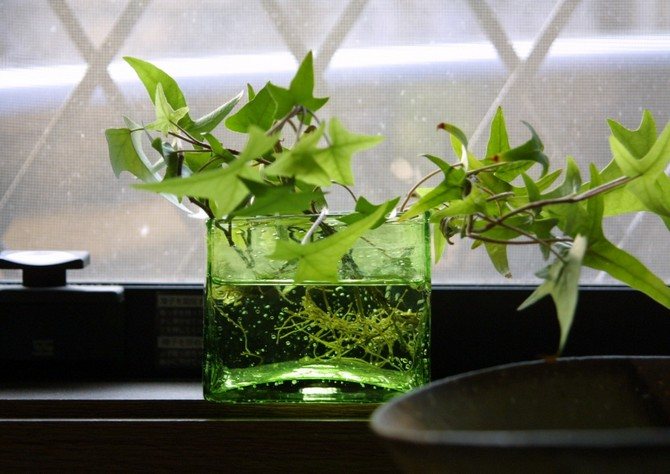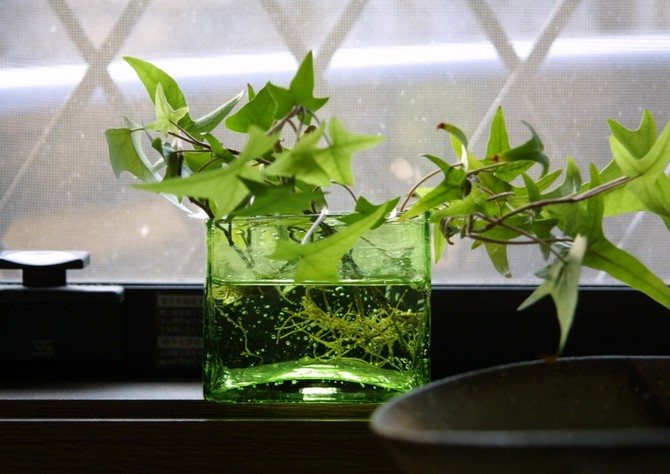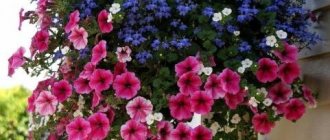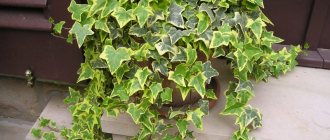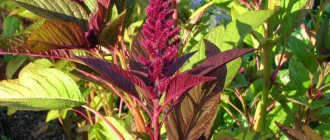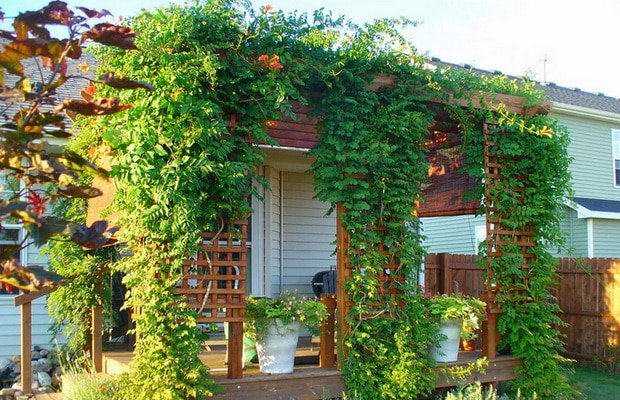
Numerous types of vines are in demand and popular in landscape design, and a variety of species and varieties of garden ivy is best suited for decorating the site, especially in the English style. Application in vertical plantings allows you to completely cover a sufficiently large surface. Clinging to the walls with the facades of buildings, they create magnificent carpets of green foliage. In addition, ivy is often used as a ground cover plant, simply letting the vine curl along the ground.
Ivy has rightfully earned the title of a multifaceted talent, because among garden plants it is difficult to find at least one plant that could be used in ornamental gardening in the same diversified manner. The climbing plant, which many know only from its humble house fellow, is actually not so boring at all. The rich colors of dark greenery, a variety of shapes and colors of amazingly graceful carved leaves, which are densely strewn with thin flexible shoots, are the basis of its unique charm.
At the same time, ivy also retains its attractiveness throughout the year, being an evergreen crop. In the garden, this modest and undemanding magician is capable of real miracles: he easily drapes empty planes, creates luxurious carpets, acts as an openwork alternative to boxwood, is suitable for creating complex shapes and exclusive designs.
What is this plant?
The genus of plants of the Aralievye family, numbering 15 species, is united under the name "ivy". K. Linnaeus borrowed the Latin name Hedera for these plants from the Romans. Ivy are creeping shrubs that cling to supports (trees, walls, etc.) as they grow. On the stems there are dense leathery leaves of an angular-lobed shape. The color is dark green, there are decorative forms with milky white stripes.
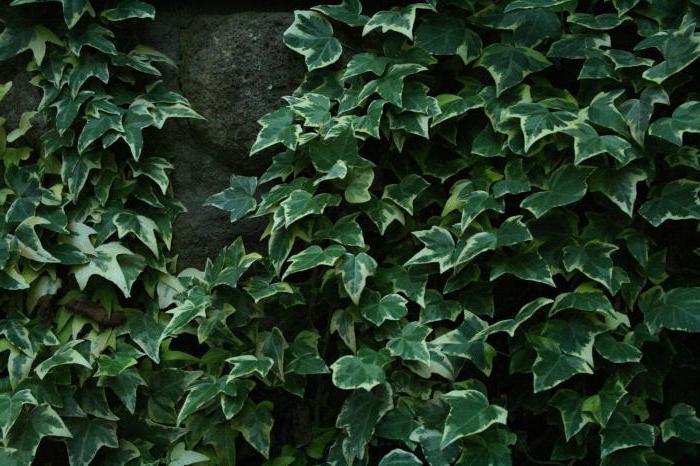

Natural habitat - the countries of the Northern Hemisphere with mild climatic conditions, as well as Australia. In our country, ivy is mainly a houseplant.
Home care
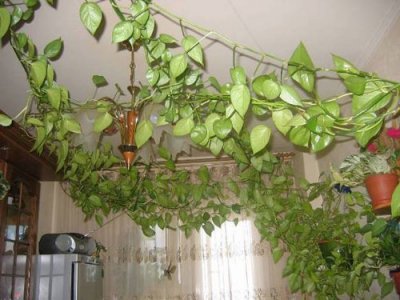

The more common name for ivy is bindweed... So he was dubbed for the ability to braid walls with long, tenacious shoots.
There are over 30 species of ivy. One of the most common is hedera helix (Latin Hedera heliks) or curly ivy.
If you decide to have indoor ivy, taking care of it at home is not difficult. Hedera Helix Enough unpretentious.
It multiplies rapidly, wrapping around walls and ceilings with a living green mass, clinging to any support due to micro-suckers (aerial roots) on the shoots.
This species has a large number of varieties, they all differ in the shape and color of the foliage: Hedera helix Harald - ivy with round leaves, Hedera helix sagittaefolia - the leaves of this species resemble stars in shape, Hedera helix Jubilee (anniversary) - with variegated leaf color.
Care after purchase
Ivy rarely comes on sale from domestic nurseries, it is mainly bought in Holland, transported in a special substrate that does not absorb water. That is why after buying a flower needs a transplant.
It is necessary to give him some time to adapt to new conditions (7-10 days). Ivy does not tolerate drought very easily, so it is not worth delaying the transplant.They are transplanted to the heder carefully. The root system is completely cleared of soil, taking care not to damage individual roots.
Common types of ivy
- Colchis ivy is an evergreen liana-shaped shrub with large (up to 25 cm in length) leathery leaves attached to the stem, with suckers. The shape of the plate can be different; when rubbed, a characteristic musky smell appears. It climbs to a height of up to 30 m. It grows quickly, but in comparison with ordinary ivy it is less frost-resistant. Under natural conditions, it grows in Iran, Transcaucasia, Asia Minor.
- Common ivy is an evergreen liana, leathery leaves of medium size (up to 10 cm in length), the arrangement is regular. It grows slowly, shade-tolerant and thermophilic, picky about soil fertility. It has a high decorative effect, and therefore has been used for a very long time in gardening gardens as a ground cover and climbing plant. Many hybrid forms have been bred, differing in color and leaf shape. The photo shows the Calico cultivar.


- Canary ivy is an evergreen shrub that is extremely popular as a houseplant. A spectacular plant with variegated leaves does not tolerate frost, requires good lighting, warmth and fertile soil.
- Pastukhova's ivy is a rare evergreen liana that grows in the Eastern Transcaucasia and is listed in the Red Book of Russia. Distributed both in mountainous areas and in lowlands, spreads along the ground and clings to tree trunks.
Hedera: description and photo
Hedera vulgaris has a climbing stem, on the underside of which there are dense brushes of aerial roots. It is with their help that the plant is attached to the support. Lobed leaves (3 - 7 lobes), leathery, shiny, simple, alternate. Their color is mainly dark green with light veins, but variegated species are also found.
Common ivy blooms only in natural conditions. It has small flowers of a greenish-yellow color, collected in racemose, corymbose or umbellate inflorescences.
The following types of ivy are commonly grown at home:
- ivy fatskhedera Lisa;
- canary ivy;
- curly ivy (ordinary).
Fatskhedera ivy Lise is a very popular new hybrid, reaching a height of up to 5 meters and requiring tying. The Variegata variety with a beige border or white spots on the leaves looks very impressive.
Canary ivy... This species has large leaves, in most cases of a variegated color, needs to be tied up, since it is unable to independently cling to a support. Gloire de Marengo is considered to be especially popular with its excellent combination of green and cream shades on the leaves.
Ivy... The plant has unusual plasticity and is able to twine around any support and cling to even small irregularities.
Popular varieties of this species:
- Littl Diamond. The plant has cream-colored veins.
- Chicago Variegata. Bright green leaves, decorated with a yellow-cream border.
- Annette with dark green leaves.
- Chicago. It has small bright green leaves.
Ivy application
The healing properties of heder have long been known to mankind, due to which ivy is still widely used in folk medicine and cosmetology. The substances contained in the wood of the plant perfectly relieve spasms, so ivy is successful used to treat acute bronchitis... And hedera leaves have expectorant, antibacterial, anticancer and antifungal properties. Gels made from wood and ivy leaves are used as an additional treatment for cellulite, obesity and purulent dermatoses. However, care should be taken as the fruits of the plant are very poisonous and can cause poisoning.
Can heder be grown at home?
According to old people, indoor ivy is an energy vampire that can attract all kinds of troubles and misfortunes, including loneliness, into the house, so if you value your family and do not want to lose your husband, this flower should not be kept in the apartment. However, according to historical documents in Ancient Rome and Greece, ivy, on the contrary, was considered a symbol of fidelity and happiness in marriage, and in the countries of the East, the plant is still a source of vital energy. Therefore, everyone chooses for himself: is it worth growing ivy at home or not.
Indoor ivy: can I keep it at home? Signs
Signs and superstitions of various kinds have always been present in our life. Some believe in them, others do not, and still others listen. Quite a lot of superstitions are associated with plants in the house, and people often find it difficult to say where they came from. Most of it sounds unreasonable at all. For example, about a donated flower, which dried up after a couple of months, and therefore was not presented from the heart. An absolutely untenable argument. Shop flowers often have a weakened immune system and can hardly tolerate a change in environment and microclimate.
Indoor ivy did not go unnoticed by amateurs. Can this plant be kept at home (signs are given in the text)? It is possible, and most Europeans do so. They do not need to plant it indoors, a beautiful plant braids the house outside, covering all the walls with an even carpet of greenery. But is this such a significant difference ?!
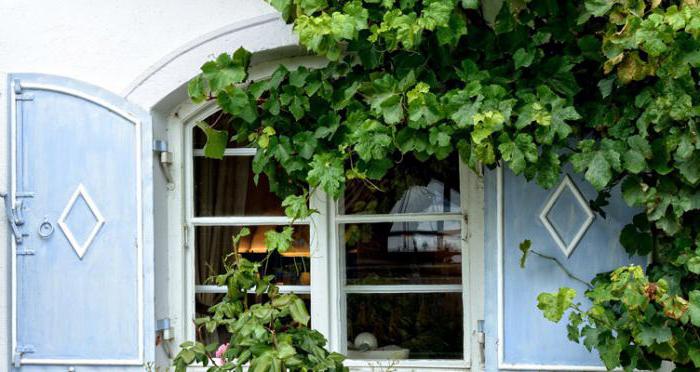

The main superstition about ivy lies in its alleged ability to "expel" men from the house, to survive them. Agree, the plant is endowed with a very impressive power. The ancient Greeks also treated ivy in a special way, but from a positive point of view. The plant was almost sacred, because according to legend, it was it that saved the life of the god of wine Dionysus (Bacchus). Since then, his images have been adorned not only with the vine, but also with the climbing stems of ivy. The mythological properties of the plant, however, have a real basis. It is used along with rosemary in France to protect forests from wildfires.
Ivy is a climbing evergreen shrub and, who would have thought, one of the symbols of Christmas. It is with this spectacular plant that Europeans, especially the British, decorate temples and houses. It is interpreted as a symbol of eternity and resurrection, affection and love. Ivy is used in tandem with holly, with the former being considered a symbol of the feminine principle (requiring support and protection), and the latter as a masculine one. In practice, the plant really amazes with its unpretentiousness and ability to survive even in the homes of the most careless flower growers.
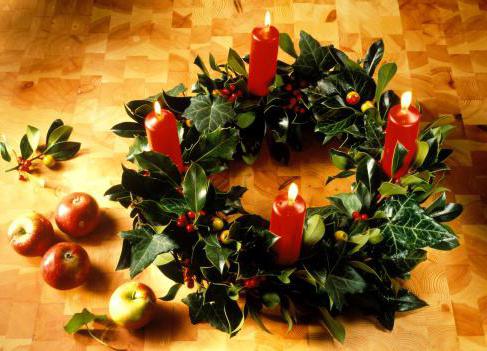

Ivy builds up a very voluminous green mass, and therefore is considered one of the most effective air purifiers. Quite a useful quality for city apartments.
These facts quite reasonably answer whether indoor ivy is harmful, whether it can be kept at home. Signs are often far-fetched and absurd. You should not blindly trust them, let alone be guided.
Possible difficulties when growing a houseplant
Growing a hederu, a florist may face some difficulties. These include drying out, dropping or discoloration of the leaves, as well as infection of the flower by harmful insects.
Why leaves or the whole plant dry
If the leaves of the plant begin to dry, this should be taken as a signal for help. To prevent the ivy from drying out completely, the hostess should reconsider the organization of care.
The first and most common cause of leaf drying is a lack of moisture. The roots of the chedera are located almost on the surface, so it reacts very sharply to the drying out of the topsoil.
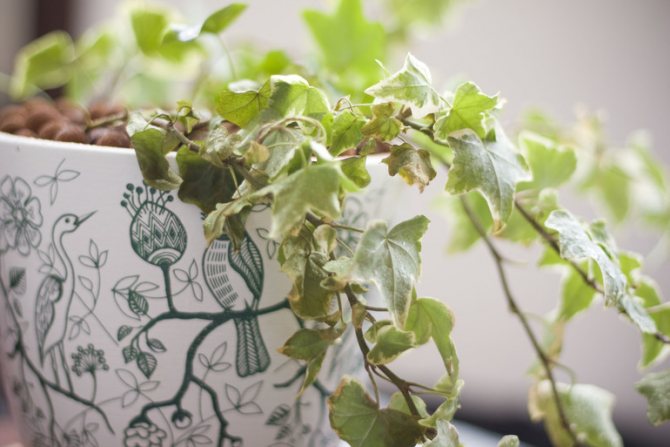

Ivy with drying leaves
Dry air also contributes to the drying of the plates.The flower can also react to the lack of moisture in the air with leaf fall.
Another reason for leaf fall may be a lack of light. Despite the fact that the flower belongs to the group of shade-loving plants, it still needs a certain amount of light.
Ivy can lose leaves for a natural reason - old age. Over time, the adult plant leaves the leaves at the base of the stem. This problem can be solved with anti-aging pruning.
Leaves shrink or change color
Small leaves located far from each other indicate incorrect lighting. If such a flower is moved to a more sunny place, it will release larger leaves, the interval between which will be noticeably reduced.
The leaves of the plant may turn yellow. Most often this happens for two reasons: waterlogging and excess fertilization. As soon as watering and feeding are organized correctly, the ivy will stop turning yellow.
Variegated varieties of heders can lose their brightness in color. Fading is the result of poor lighting. Variegated ivy, unlike dark green species, need more light. If kept in partial shade, they will lose their decorative color, turning into ordinary green ivy.
An uncomfortable pot can also cause loss of decorative pattern. The roots of the heder are prone to overgrowth, so the flower feels uncomfortable in tightness.
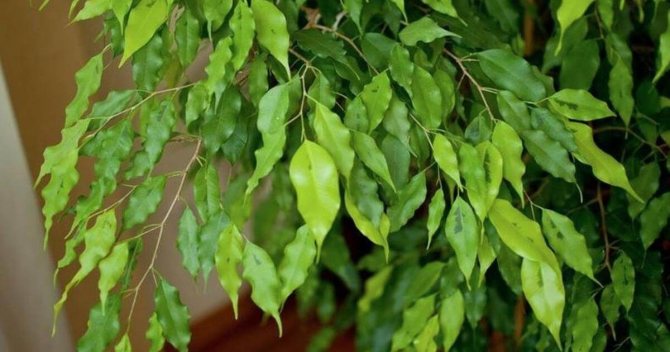

You may be interested in:
Ficus Benjamina - caring for a houseplant at home Ficus is one of the most popular indoor plants. Representatives of this species look equally impressive as in ... Read more ...
How to recognize pests
The flower often falls prey to aphids, scale insects and spider mites. Pests can be recognized by the following signs:
- Aphid. A dangerous pest that feeds on plant sap. As a rule, it attacks in whole columns. Aphid infestation can be determined by yellowing and withering leaves, as well as by careful examination of the flower: small transparent bugs can be seen on the stems and petioles.
- Shield. A sign of infestation with these pests is growth retardation and leaf fall. On the inside of the leaf, you can see small wax dots - the waste products of insects.


Scale insects on leaves - Spider mite. The most dangerous pest that can kill a cheder in 2 weeks. It is almost impossible to notice a tick without using magnifying devices. But its thin cobweb, which the mite generously leaves on the petioles, stems and the back of the leaf, can be easily seen with the naked eye.
On a note!
To combat pests, use a solution of laundry soap or specialized insecticidal preparations.
Site selection, lighting and temperature
Indoor ivy is a unique plant. Choosing it for your home, you can fill even the darkest corner of the room with greenery. He is very shade-tolerant. However, variegated forms need sun to maintain a beautiful contrast on the leaves, it is best if it is slightly muffled, avoid direct rays of the plant.
Ivy belongs to evergreen, heat-loving plants. The most comfortable temperature for him will be 22-25 ° С in the spring-summer period and cooler (15-18 ° С) in winter. You can take it out to the balcony or summer terrace.
Ivy soil
The plant prefers light but nutritious soils. You can buy ready-made soil in a specialized store or prepare it yourself. To do this, mix sod and leafy soil, humus, peat and sand in equal proportions. Place a drainage layer, such as expanded clay, on the bottom of the pot.
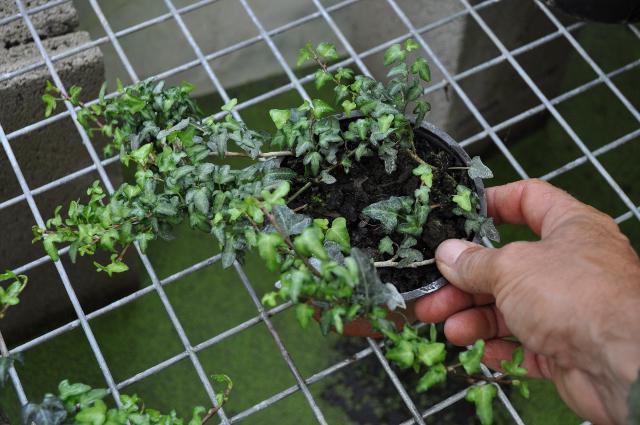

Transplantation of adult plants is carried out every two years, and young ones - annually. The most optimal time for the procedure is March-April. Pick up a planter 2-3 cm larger than the previous one.
Bonsai style
For an elegant, miniature composition, the narrow-leaved ivy shape is suitable. The plant is planted in a low bowl of small volume, better than a neutral tone and rectangular shape. The soil is selected stony: in equal parts sod soil, humus, sand and brick chips. As a rock, a stone with comfortable hollows is used, capable of holding ivy roots and soil sufficient to feed it. One of the main shoots of ivy, as it grows, is tilted over the rock, and it soon takes on a naturally drooping appearance. In order for ivy to bush, other shoots are often pinched.
The composition is held on a sunny window, under the scorching rays. In such extreme conditions, ivy slows down its growth.
E. Arkhipov, biologist
Watering and feeding
For active growth, ivy requires regular and abundant watering in the summer. But don't flood the plant. Low air temperature and excess moisture are a favorable environment for the development of fungal and bacterial diseases.
In winter, a mild rest period begins. At this time, the plant is watered less often, but the substrate must not be allowed to completely dry out. Spraying and high humidity is what indoor ivy prefers. Leaves dry out and fall off very often due to the dry air. If possible, periodically put the plant under the shower, covering the clod of earth with waterproof material. After such a procedure, it looks much more attractive and starts growing with renewed vigor.
Top dressing should be carried out every two weeks, from March to the end of August, alternating organic and mineral complex fertilizers.
Ivy pests and diseases
Ivy is a plant that is quite resistant to disease. He only gets into trouble if you chronically neglect the conditions for growing the plant. So, with a lack of lighting, variegated forms of ivy lose their variegation and become green, and chronically dry soil can cause leaf fall, just as too dry indoor air can cause bald stems with sparse and small foliage.
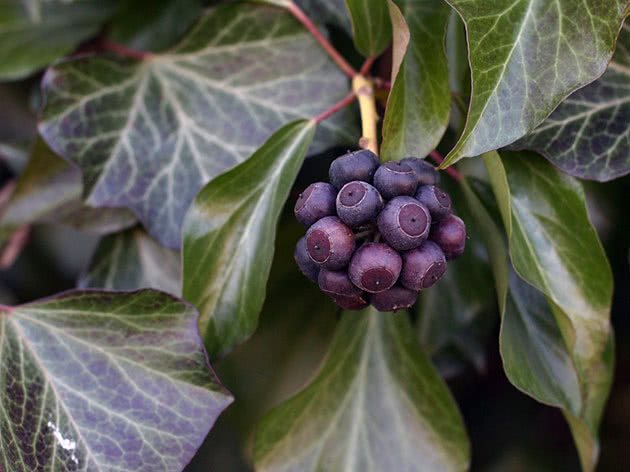

Due to your oversight, ivy is also affected by harmful insects - aphids, scale insects, cyclamen or spider mites. Usually they all appear on the plant if the room humidity is too low. You can fight these parasites by carefully spraying the plant with actellik solution at the rate of 1-2 ml of the drug per liter of water. In addition to actellik, karbofos and aktara show good results in the fight against the above pests.
If after the first spraying you could not achieve success, repeat the procedure after 3-4 days. If this is not enough, instead of spraying, rinse all the foliage in a basin with an insecticide solution.
Reproduction methods
Ivy can be propagated by vegetative or seed propagation. Moreover, the first is the simplest and can be carried out in three ways.
First, propagation by apical cuttings. The ends of shoots 10 cm long are cut off and immediately planted in a wet mixture of sand and leafy earth, covered with a glass or plastic cap on top. Thus, greenhouse conditions are created, and it is important to maintain constant moisture in the soil. You can pre-put the cuttings in water and wait for the roots to appear. Then plant in ready-made potting mix.
Secondly, shoot propagation is practiced. Several plants can be obtained from one piece of stem. To do this, take a shoot with 8-10 leaves and make a cut along it. Not too deep, it should be superficial. On the prepared moist soil, the shoot is placed with a cut down and pressed into the soil by 1.5-2 cm, leaving the leaves on the surface. Within two weeks, the plant will develop roots along its entire length, a growing tip will serve as a sign of this.Then the stem is taken out and cut into several parts, each is planted in a separate pot.
Well, the third vegetative method is reproduction by layering. The algorithm of action is the same as in the previous version, but with one amendment, the shoot from the mother plant is not separated, but pressed against the ground with staples.
Growing
In the middle lane, most species and varieties of ivy are grown only as a houseplant. It is planted in pots in soil that is not very nutrient-rich. Plants tolerate shade, but the color of variegated forms in the shade fades, as well as with an excess of nutrients in the soil.
Indoors, the plant must be kept away from direct sunlight.
Natural forms J. helix and J. colchica can be grown outdoors. The best place is in the shade of deciduous trees. It is useful for the leaf litter to remain on the ivy plantings - this serves as both a winter shelter and a source of nutrients. In the first years it grows slowly, but then forms a dense foliage cover. In some winters, it loses leaves, but renews itself from spare buds.
Pruning indoor ivy
Pruning and shaping the bush require, as a rule, street specimens. Indoor plants, if desired, can also be updated and rejuvenated, giving the desired shape. The procedure is carried out in early spring, before the plant begins its active growing season. First of all, remove diseased and damaged shoots, you can simply pinch the young ones in order to stimulate the development of lateral stems. To rejuvenate the shrub, prune old branches at a distance of 1 m from the root in outdoor conditions and half as much in indoor conditions.
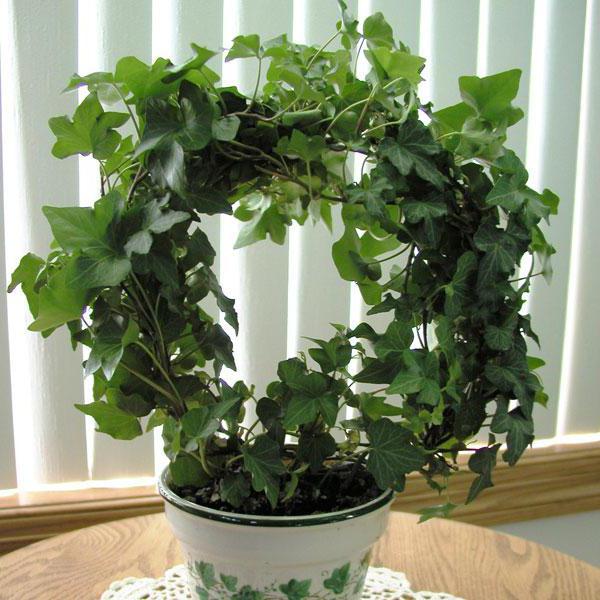

As a support for ivy, you can use a wall, specially stretched threads, but they must be strong (the green mass is quite heavy), a decorative trellis, etc.
Ivy care
Variegated varieties and species tolerate brighter lighting and even become much richer in color. It is worth noting that, nevertheless, they do not like direct sunlight. As a rule, ivy with colorful leaves is the fruit of the work of breeders. Almost all artificially bred varieties are more thermophilic than their monochromatic relatives.
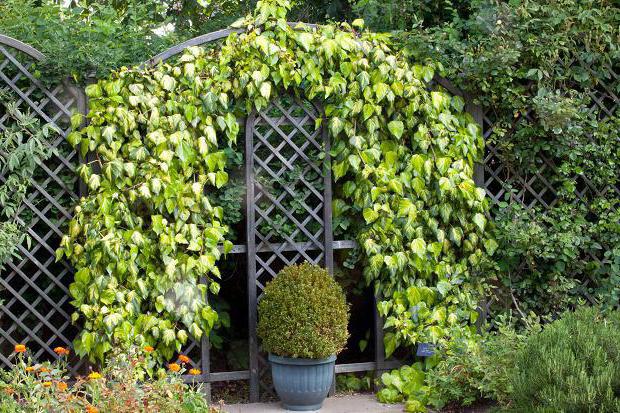

Ivy care is not difficult. Almost all species prefer fertile soils, where they will develop intensively. Loam is also great when providing sufficient moisture. But it is better not to plant them in clay soils. The vines will quickly begin to die, as there will be no oxygen access to the roots. In addition, clay is capable of retaining moisture for a long time, and excess moisture and waterlogging are not permissible in ivy growing.
For the development of a rich crown, the perennial must be fed several times over the summer. Apply nitrogen-containing fertilizers for the development and growth of the stems. It stimulates the formation of new shoots and significantly affects the appearance, and, accordingly, the decorativeness of the vine. From the middle of summer, it is worth applying fertilizers with a high content of potassium and phosphorus. These trace elements will strengthen the young shoots of the plant and give them more resistance to cold.
Caring for your ivy includes regular pruning to help create the shape you want. The procedure promotes the development of lateral shoots on the stem, due to which the vine gradually increases in volume and becomes much thicker. All dry branches are pruned as they form.
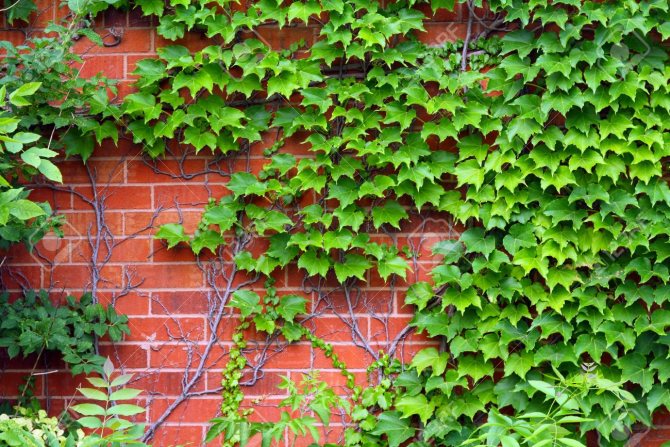

Many of the ivy varieties are capable of hibernating in open conditions. Climbing varieties in the southern regions do not need to be removed from the support and insulated, but in the central ones, they should be laid on the ground and covered a little. Do not insulate too much, as the branches can oppose. Plants that have reached large sizes can be tried not to be removed, but to insulate only their base. Miniature ivy on alpine slides winter well under a small layer of snow.But it is still worth covering them with spruce branches. In early spring, the garden ivy is uncovered and placed on the supports again.

